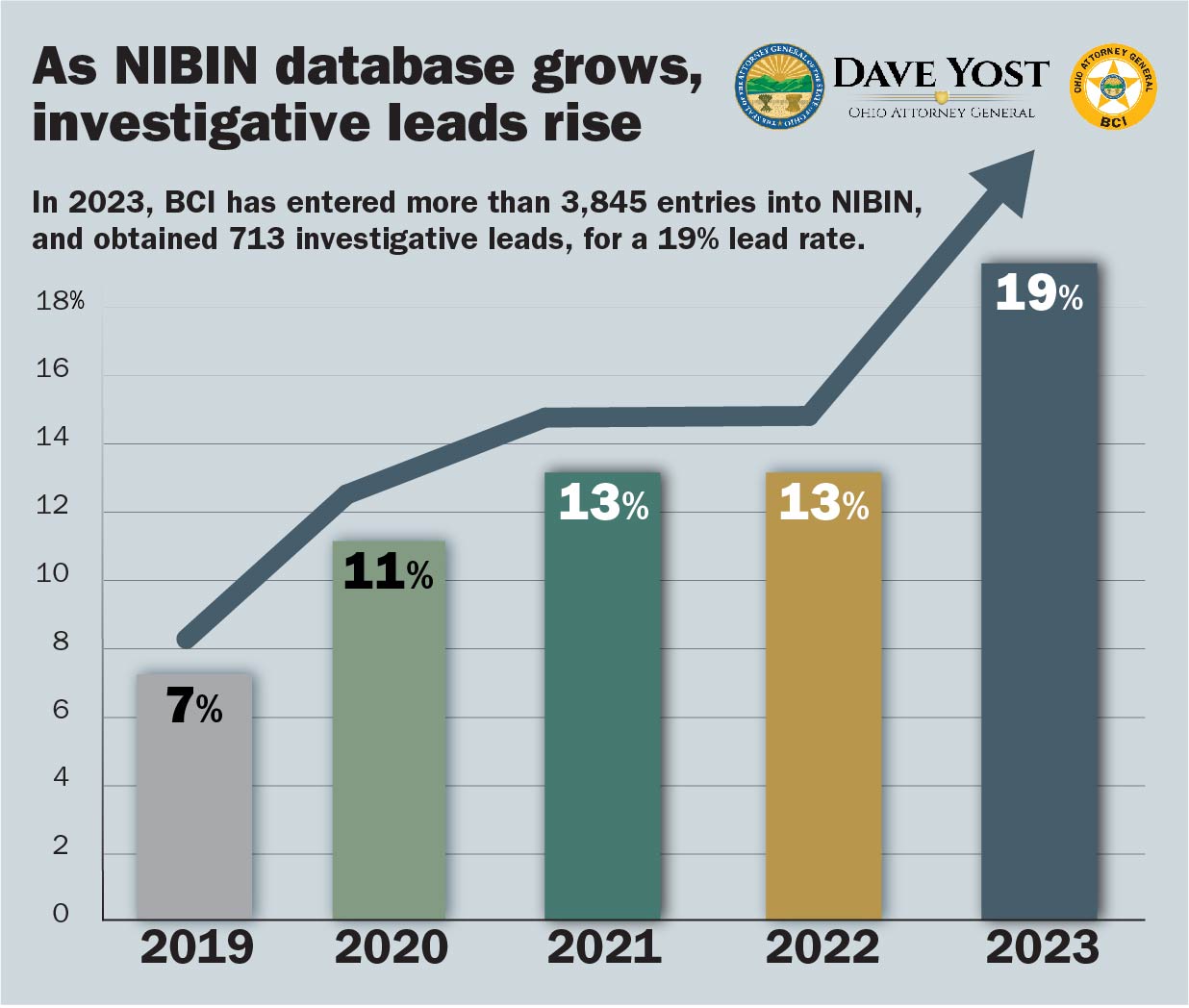(COLUMBUS, Ohio) — Six months after the expansion of digital ballistic testing, Ohio law enforcement agencies are receiving investigative results that are making a difference in solving gun crimes, Ohio Attorney General Dave Yost announced today.
“The expansion of NIBIN technology is enriching the dataset, which in turn is increasing its effectiveness,” Yost said. “But we’re not stopping there – we’ve doubled down on our efforts by incorporating DNA analysis alongside NIBIN. The early results are very encouraging.”
The Ohio Attorney General’s Bureau of Criminal Investigation (BCI) expanded NIBIN access in July to all Ohio law enforcement agencies. This expansion was made possible by the addition of five NIBIN machines at BCI’s laboratories – two in London, two in Bowling Green, and a second machine in the Richfield lab.
In the last six months, 252 Ohio law enforcement agencies have submitted to NIBIN, including 155 agencies that had previously not submitted evidence.
In 2023, BCI has entered more than 3,845 entries into NIBIN, and obtained 713 investigative leads, for a 19% lead rate.

Expanded DNA Testing for Firearms
Along with the expansion of the NIBIN program, Yost broadened the submission guidelines for DNA testing on firearms, specifically for cases involving someone possessing a weapon while under disability. Additionally, cases in which a NIBIN association is made to a non-violent gun crime are likewise eligible for DNA analysis.
The combination of NIBIN and DNA analysis has proved successful in identifying offenders, providing investigators and prosecutors valuable information to further investigations, and securing an indictment.
When a crime gun is submitted to BCI’s lab, forensic scientists work to obtain a DNA profile from the gun. If an unknown profile is developed, it is searched against previously known offenders through the Combined DNA Index System (CODIS).
Historically, obtaining DNA profiles from guns has been sporadic, since guns used in a crime are frequently handled by multiple people and have surfaces that are inherently difficult for the recovery of DNA. BCI forensic scientists have innovated processes to increase the success for DNA profiles suitable for comparisons from crime guns. BCI is providing training for law enforcement officers who initially collect firearms to continue to improve the likelihood that a DNA profile is obtained from this type of evidence.
Since July 1, BCI has:
- Identified 53 serial offenders through DNA obtained from gun crime evidence.
- Achieved a 52% CODIS hit rate from forensic DNA profiles that were obtained from gun crime evidence and were eligible for CODIS entry.
- Provided leads to law enforcement in 22 investigations involving weapons under disability cases with a known suspect standard.
Success Stories
These examples highlight some of the investigative leads provided by NIBIN that have recently aided Ohio law enforcement agencies:
- The Warren Police Department responded to a retail store for gunshots fired in the parking lot. Detectives discovered that the gunfire was directed toward a house and had struck a 9-year-old inside. In all, six people were in the house during the barrage of gunfire. Based on a video surveillance from the store, detectives identified a potential suspect and issued an arrest warrant. The suspect, Say’Quan Parks, was arrested the next day and was in possession of a firearm. The evidence was submitted to BCI’s Richfield lab, and NIBIN technology was used to help detectives link the cartridge cases recovered from the scene with the firearm recovered from Parks. Parks was charged and sentenced to a minimum of 25½ years in prison.
- In a case investigated by the Akron Police Department, during a police pursuit, officers were fired on by two suspects. The vehicle managed to elude officers, but afterward, cartridge cases were collected and sent to BCI for NIBIN and DNA testing. DNA testing revealed the identity of a known gang member.
- In a recent northeast Ohio case, a NIBIN lead linked a homicide under investigation by the Ashtabula County Sheriff’s Office with a firearm recovered by the Ashtabula City Police Department. BCI’s Criminal Intelligence Unit assisted the homicide investigation and a suspect was ultimately charged with a number of offenses, including aggravated murder, aggravated robbery and attempted murder. The suspect is awaiting trial.
How NIBIN works
When a firearm is fired, it leaves a unique marking on a cartridge case. Cartridge cases collected at a crime scene can be entered into NIBIN and compared to images of cartridge cases recovered from other crime scenes, potentially linking crimes and firearms.
Law enforcement agencies submit cartridge cases and crime guns to a BCI lab for NIBIN entry. Specially trained BCI technicians enter the evidence into NIBIN, and the images are then correlated by BCI or the ATF’s NIBIN National Correlation and Training Center.
When a cartridge case is matched, a lead is created and a correlation report is sent to the case investigator. Upon receiving the report, an investigator can, if needed, request further assistance from BCI in developing the lead. Those resources include the bureau’s:
- Firearms Unit, which performs comparative forensic analysis.
- DNA Unit, which can obtain offender profiles from firearms and cartridge cases.
- Criminal Intelligence Unit, which provides digital forensics, data mapping and analysis, and subject intelligence.
Media Resources
Hear from AG Yost
NIBIN Step-by-Step video
MEDIA CONTACT:
Steve Irwin: 614-728-5417
-30-